Continental Currency
May 20, 1777
An emission totaling $16,500,000 payable in Spanish milled dollars, or the equivalent in gold or silver, was authorized by ten Continental Congress resolutions passed between May 20, 1777 and April 18, 1778. The issue is similar to that of July 22,1776 with some modifications. The ornament and type fonts for the back of the bills was modified. Also, this was the first issue to use the legend "THE UNITED STATES" replacing the former designation as the United Colonies. Because of extensive British counterfeiting the bills were recalled for an exchange on January 2, 1779 (compare our examples of an original and a counterfeit $8 bill below). However, new bills were not always available and the recall needed to be extended to January 1781! By that date the bills were almost worthless because of hyperinflation (in January 1781 $1 in specie traded for $75 continental in most states, while in Maryland it took $110 continental dollars and in North Carolina $210 continental dollars to obtain $1 in specie). Printed by Hall and Sellers in Philadelphia. The paper, made at Ivy Mills in Chester County, Pennsylvania, contained blue fibers and mica flakes. Detector bills were printed on blue paper. Denominations include the: $2, $3, $4, $5, $6, $7, $8 and $30.obv
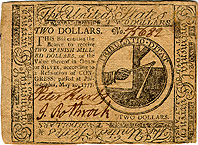 rev
rev
$2 Serial Number: 75,682 CC 05/20/77
Signers: Peter Kurtz, J. Rothrock.
Size: 73 x 98mm (front border design: 70 x 92mm; back border design: 67 x 89mm).
Comments: Numbered and signed in black ink. The emblem on the front shows grain being threshed with a flail with the motto: "Tribulatio ditat" (It is enriched by affliction). The nature print on the back is of rasberry and two filbert leaves and is identical to the nature print used on earlier Pennsylvania currency. Paper contains blue threads and mica flakes.
Provenance: EANA mail bid auction 1/13/96 lot 295. Purchased through the Robert H. Gore, Jr. Numismatic Endowment.
obv
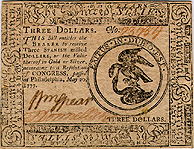 rev
rev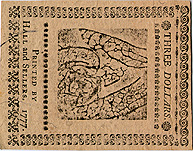
$3 Serial Number: 73,784 CC 05/20/77
Signers: William Spear, Thomas Donnellan
Size: 73 x 94mm (front border design: 70 x 93mm; back border design: 66 x 88mm).
Comments: The emblem on the front depicts an eagle fighting a heron with the motto "Exitus in dubio est" (The outcome is in doubt). On the back is a nature print of skeletonized elm and maple fruit. The paper contains blue threads and mica flakes.
Provenance: EANA mail bid auction 4/20/96 lot 393. Purchased through the Robert H. Gore, Jr. Numismatic Endowment.
obv
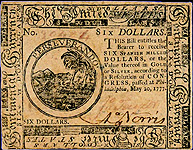
$6 Serial Number: 30,424 CC 05/20/77
Signers: John Taylor (in red), Aquilia Norris
Size: not available
Comments: Numbered and first signature in red, the second signature is in a dark brown ink. The emblem on the front shows a beaver gnawing down a tree with the motto: "Perseverando" (By perseverance). The nature print on the back displays a buttercup. No image of the back is available. Ther paper contains blue threads and mica flakes.
Courtesy of Early American Numismatic Auctions, Inc. Images used with permission from their on-line auction catalog for the auction of April 20, 1996, lot 395.
obv
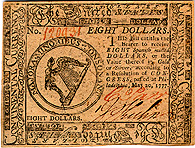 rev
rev
$8 Serial Number: 120,931 CC 05/20/77
Signers: C. Parr (in red ink), J. Kuhn.
Size: 72 x 95mm (front border design: 69 x 92.5mm; back border design: 68 x 90mm).
Comments: Numbering and first signature in red ink; second signature in black ink. The emblem on the front shows a harp with thirteen strings with the motto: "Majora minoribus consonant" (The larger are in harmony with the smaller). The nature print on the back, though indistinct, is of henebit and two buttercups and is identical to the nature print used on earlier Pennsylvania currency. Paper contains blue threads and mica flakes.
Provenance: EANA mail bid auction 1/13/96 lot 299. Purchased through the Robert H. Gore, Jr. Numismatic Endowment.
obv
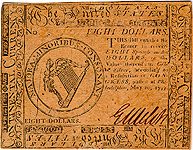 rev
rev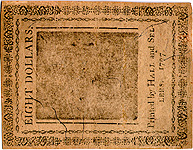
$8 Counterfeit Serial Number: 89,127 (in faded reddish-brown ink) CC 05/20/77
Signers: S. Elms, George Welsh (these signatures are forgeries).
Size: 72 x 93mm (front border design: 69 x 92mm; back border design: 68 x 89mm).
Comments: The numbering and first signature in a very faded red ink; second signature in black ink. The emblem on the front shows a harp with thirteen strings with the motto: "Majora minoribus consonant" (The larger are in harmony with the smaller). The nature print on the back, though indistinct, is of henebit and two buttercups.
This bill is a counterfeit, one of two different counterfeits from engraved copperplate described by Newman. Distinguishing marks noted by Newman and described in the official broadside are the following: (1) the base of the 'I' in "MINORIBUS" is high, (2) the baseline of the harp rises to the right instead of being horizontal, (3) words in the text are too short, and (4) the 'O' and 'E' in "CONGRESS are low. and can be distinguished from the original by the finer line of the engraved border cuts and emblem and darker paper. Other differences include the following: (1) the 'V' which appears just after "EIGHT" in the lower portion of the left border cut is linked to the script in the original but is separate in the counterfeit; (2) the stems of the three 7s in "1777" on the back form a descending diagonal in the counterfeit but a straight line in the original. Like the original, the paper used in this counterfeit contains blue threads and mica flakes.
Provenance: EANA mail bid auction 1/13/96 lot 299. Purchased through the Robert H. Gore, Jr. Numismatic Endowment.